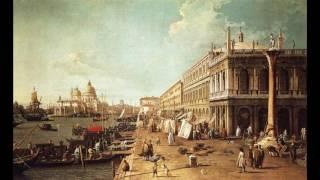
Canaletto 卡納萊托 (1697-1768) Venetian painter
Canaletto
卡納萊托
(1697-1768)
Venetian painter
Giovanni Antonio Canal, Venetian painter, the son of Bernardo Canal, a well-known scenery painter at the time. 'Canaletto' - or small canal - as he was soon called, received his training in the studio of his father and his brother, with whom he continued to collaborate for several years. He became the most famous view-painter of the 18th century.
He began his career as a theatrical scene painter (his father's profession), but he turned to topography during a visit to Rome in 1719-20, when he was influenced by the work of Giovanni Paolo Pannini. In Rome, in his own words, 'irritated by the immodesty of the playwrights, [he] formally foreswore the theatre,' to devote himself entirely to painting al naturale (from nature). It is not entirely clear what inspired him to this, but it was most likely his acquaintance with the work, and possibly also the person, of Caspar van Wittel.
By 1723 he was painting picturesque views of Venice, marked by strong contrasts of light and shade and free handling, this phase of his work culminating in the splendid Stone Mason's Yard (c. 1730, National Gallery, London,). Meanwhile, partly under the influence of Luca Carlevaris, and largely in rivalry with him, Canaletto began to turn out views which were more topographically accurate, set in a higher key and with smoother, more precise handling - characteristics that mark most of his later work. At the same time he began painting the ceremonial and festival subjects which ultimately formed an important part of his work.
His patrons were chiefly English collectors, for whom he sometimes produced series of views in uniform size. Conspicuous among them was Joseph Smith, a merchant, appointed British Consul in Venice in 1744. It was perhaps at his instance that Canaletto enlarged his repertory in the 1740s to include subjects from the Venetian mainland and from Rome (probably based on drawings made during his visit as a young man), and by producing numerous capricci. He also gave increased attention to the graphic arts, making a remarkable series of etchings, and many drawings in pen, and pen and wash, as independent works of art and not as preparation for paintings. Meanwhile, in his painting there was an increase in an already well-established tendency to become stylized and mechanical in handling. He often used the camera obscura as an aid to composition. In 1746 he went to England, evidently at the suggestion of Jacopo Amigoni (the War of the Austrian Succession drastically curtailed foreign travel, and Canaletto's tourist trade in Venice had dried up).
For a time he was very successful painting views of London and of various country houses. Subsequently, his work became increasingly lifeless and mannered, so much so that rumours were put about, probably by rivals, that he was not in fact the famous Canaletto but an impostor. In 1755 he returned to Venice and continued active for the remainder of his life. Legends of his having amassed a fortune in Venice are disproved by the official inventory of his estate on his death. Before this, Joseph Smith had sold the major part of his paintings to George III, thus bringing into the royal collection an unrivalled group of Canaletto's paintings and drawings. Canaletto was highly influential in Italy and elsewhere. His nephew Bernardo Bellotto took his style to Central Europe and his followers in England included William Marlow and Samuel Scott.
卡納萊托(喬凡尼·安東尼奧·康納爾)(Canaletto,1697-1768年),義大利風景畫家,尤以準確描繪威尼斯風光而聞名。在《聖馬可廣場》、《大運河上的賽船》,及其他作品中,他將準確的建築細節與明亮的色彩結合起來。卡納萊托出生於威尼斯。他跟隨他的父親開始職業生涯,在威尼斯和羅馬畫舞臺場景。1720年左右,他轉向風景畫。他的威尼斯風光畫很快受到遊客的歡迎,作為特產買走。卡納萊托的有些風景畫,將真實建築置於想像的背景中。
18世紀義大利最著名的風景畫家卡納萊托(Canaletto)在其故鄉威尼斯畫了許多精緻的風景畫。這些風景畫畫面十分逼真,以至於今天氣象學家可以將它們用作氣候研究。義大利科學家希望借此填補一個氣候資料的缺口。實際上,人們直到140年以後才正式測量了威尼斯的水位。
卡納萊托在18世紀30年代到40年代期間用一架針孔照相機把攝得的畫面投影到幕布上,然後在幕布上精確地描繪威尼斯的風景。在他的畫中就連威尼斯運河裡最細微的海藻堆都被記錄下來了,因此他的畫被選來比較現在和當時的氣候情況。
卡納萊托
(1697-1768)
Venetian painter
Giovanni Antonio Canal, Venetian painter, the son of Bernardo Canal, a well-known scenery painter at the time. 'Canaletto' - or small canal - as he was soon called, received his training in the studio of his father and his brother, with whom he continued to collaborate for several years. He became the most famous view-painter of the 18th century.
He began his career as a theatrical scene painter (his father's profession), but he turned to topography during a visit to Rome in 1719-20, when he was influenced by the work of Giovanni Paolo Pannini. In Rome, in his own words, 'irritated by the immodesty of the playwrights, [he] formally foreswore the theatre,' to devote himself entirely to painting al naturale (from nature). It is not entirely clear what inspired him to this, but it was most likely his acquaintance with the work, and possibly also the person, of Caspar van Wittel.
By 1723 he was painting picturesque views of Venice, marked by strong contrasts of light and shade and free handling, this phase of his work culminating in the splendid Stone Mason's Yard (c. 1730, National Gallery, London,). Meanwhile, partly under the influence of Luca Carlevaris, and largely in rivalry with him, Canaletto began to turn out views which were more topographically accurate, set in a higher key and with smoother, more precise handling - characteristics that mark most of his later work. At the same time he began painting the ceremonial and festival subjects which ultimately formed an important part of his work.
His patrons were chiefly English collectors, for whom he sometimes produced series of views in uniform size. Conspicuous among them was Joseph Smith, a merchant, appointed British Consul in Venice in 1744. It was perhaps at his instance that Canaletto enlarged his repertory in the 1740s to include subjects from the Venetian mainland and from Rome (probably based on drawings made during his visit as a young man), and by producing numerous capricci. He also gave increased attention to the graphic arts, making a remarkable series of etchings, and many drawings in pen, and pen and wash, as independent works of art and not as preparation for paintings. Meanwhile, in his painting there was an increase in an already well-established tendency to become stylized and mechanical in handling. He often used the camera obscura as an aid to composition. In 1746 he went to England, evidently at the suggestion of Jacopo Amigoni (the War of the Austrian Succession drastically curtailed foreign travel, and Canaletto's tourist trade in Venice had dried up).
For a time he was very successful painting views of London and of various country houses. Subsequently, his work became increasingly lifeless and mannered, so much so that rumours were put about, probably by rivals, that he was not in fact the famous Canaletto but an impostor. In 1755 he returned to Venice and continued active for the remainder of his life. Legends of his having amassed a fortune in Venice are disproved by the official inventory of his estate on his death. Before this, Joseph Smith had sold the major part of his paintings to George III, thus bringing into the royal collection an unrivalled group of Canaletto's paintings and drawings. Canaletto was highly influential in Italy and elsewhere. His nephew Bernardo Bellotto took his style to Central Europe and his followers in England included William Marlow and Samuel Scott.
卡納萊托(喬凡尼·安東尼奧·康納爾)(Canaletto,1697-1768年),義大利風景畫家,尤以準確描繪威尼斯風光而聞名。在《聖馬可廣場》、《大運河上的賽船》,及其他作品中,他將準確的建築細節與明亮的色彩結合起來。卡納萊托出生於威尼斯。他跟隨他的父親開始職業生涯,在威尼斯和羅馬畫舞臺場景。1720年左右,他轉向風景畫。他的威尼斯風光畫很快受到遊客的歡迎,作為特產買走。卡納萊托的有些風景畫,將真實建築置於想像的背景中。
18世紀義大利最著名的風景畫家卡納萊托(Canaletto)在其故鄉威尼斯畫了許多精緻的風景畫。這些風景畫畫面十分逼真,以至於今天氣象學家可以將它們用作氣候研究。義大利科學家希望借此填補一個氣候資料的缺口。實際上,人們直到140年以後才正式測量了威尼斯的水位。
卡納萊托在18世紀30年代到40年代期間用一架針孔照相機把攝得的畫面投影到幕布上,然後在幕布上精確地描繪威尼斯的風景。在他的畫中就連威尼斯運河裡最細微的海藻堆都被記錄下來了,因此他的畫被選來比較現在和當時的氣候情況。
Тэги:
#Western_art_history #EducationalCanaletto #卡納萊托 #(1697-1768) #Venetian_painterКомментарии:
Canaletto 卡納萊托 (1697-1768) Venetian painter
Tuen Tony Kwok
SAANS bCPAP Setup & Assembly
InnAccel Technologies Pvt Ltd
Zazen Online October 12th 2024 11h00 (CEST) / 10h00 (BST)
Monastère Bouddhiste Kanshōji
WATCH NOW: FULL GATHERING from Passion City Church!
Passion City Church
US Presidents Play NBA 2K24 (FULL SERIES)
TheFinnFTW


























